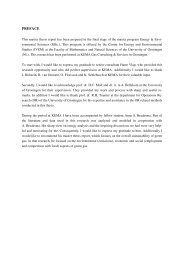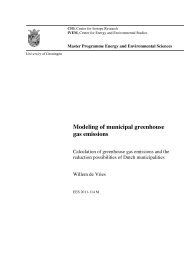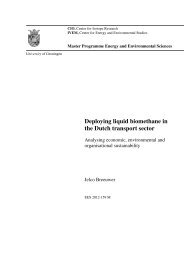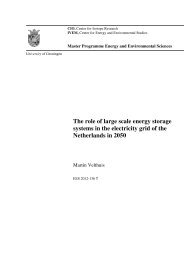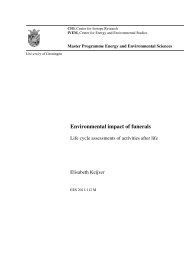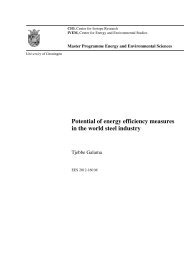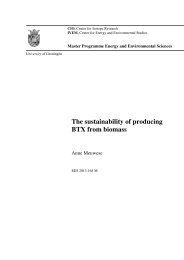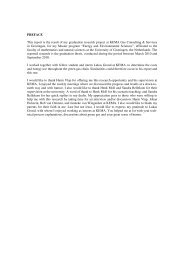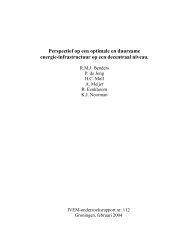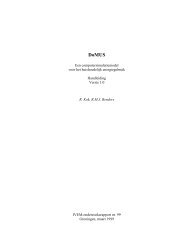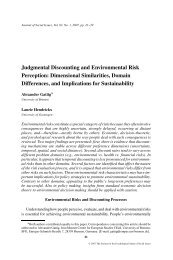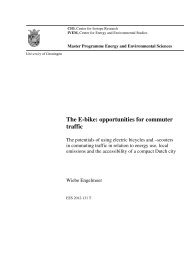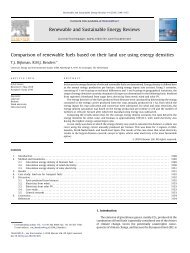Broadband dye-sensitized upconversion of near-infrared light
Broadband dye-sensitized upconversion of near-infrared light
Broadband dye-sensitized upconversion of near-infrared light
You also want an ePaper? Increase the reach of your titles
YUMPU automatically turns print PDFs into web optimized ePapers that Google loves.
NATURE PHOTONICS DOI: 10.1038/NPHOTON.2012.158 ARTICLES<br />
NIR<br />
NIR<br />
Antenna<br />
FRET<br />
with ≏975 nm laser <strong>light</strong>. A commercially available cyanine <strong>dye</strong>,<br />
IR-780, was selected as the starting material for the preparation <strong>of</strong><br />
functionalized antenna molecules to be attached to the surface <strong>of</strong><br />
the nanoparticles. Nucleophilic substitution <strong>of</strong> the central chlorine<br />
atom in IR-780 was used as the method to prepare a carboxylic<br />
acid-functionalized derivative (see Supplementary Sections A–C<br />
for details). The resulting carboxylated <strong>dye</strong> absorbs <strong>light</strong> mainly<br />
between 650 and 850 nm, with a maximum at 806 nm in CHCl 3<br />
(Fig. 2a); we therefore named it IR-806. The extinction coefficient<br />
<strong>of</strong> IR-806 at 806 nm is 390 l g 21 cm 21 , which is ≏5 × 10 6 times<br />
higher than that <strong>of</strong> b-NaYF 4:Yb,Er nanoparticles at 975 nm<br />
(7 × 10 25 lg 21 cm 21 ). Weak absorption <strong>of</strong> IR-806 below 600 nm<br />
is also essential, because the antenna <strong>dye</strong> should be transparent<br />
for the upconverted photons that exit the nanoparticle.<br />
At 750 nm excitation, the emission spectrum <strong>of</strong> IR-806 in<br />
CHCl 3 extends well beyond 900 nm (Fig. 2b). The overlap<br />
between the emission spectrum <strong>of</strong> IR-806 and the absorption<br />
spectrum <strong>of</strong> the nanoparticles at 900–1,000 nm, albeit not<br />
optimal, still allows for Förster-type energy transfer from<br />
excited IR-806 to the Yb 3þ absorption centres in the nanoparticles.<br />
The exchange reaction with the oleylamine ligands and<br />
binding <strong>of</strong> IR-806 to the surface <strong>of</strong> the nanoparticle were determined<br />
by clearly observable changes <strong>of</strong> absorption in the NIR<br />
and <strong>infrared</strong> regions as well as in the emission properties<br />
(Supplementary Figs S6–S8). First, following the addition <strong>of</strong> oleylamine-coated<br />
nanoparticles to a solution <strong>of</strong> IR-806 in CHCl 3,the<br />
absorption <strong>of</strong> IR-806 at 806 nm decreased and the absorption<br />
maximum wavelength gradually blueshifted from 806 nm to a saturation<br />
value <strong>of</strong> 800 nm (Supplementary Fig. S7a). Second, the<br />
IR-806 luminescence decreased to 35% <strong>of</strong> the original intensity<br />
(Supplementary Fig. S8a). In a blank experiment in which<br />
IR-806 was bound to oleylamine-coated NaYF 4 nanoparticles<br />
with no Yb and Er photon energy acceptors, an identical blueshift<br />
in IR-806 absorption was observed (Supplementary Fig. S7b), but<br />
the luminescence decrease was only to 90% <strong>of</strong> the original intensity<br />
(Supplementary Fig. S8b). Third, the lifetime <strong>of</strong> IR-806<br />
luminescence shortened from 1.14 ns (pure IR-806) to 0.64 ns<br />
(IR-806:nanoparticle) upon binding to the NaYF 4:Yb,Er nanoparticles<br />
(Supplementary Fig. S9). This set <strong>of</strong> experiments<br />
FRET<br />
Upconverter<br />
Figure 1 | Principal concept <strong>of</strong> the <strong>dye</strong>-<strong>sensitized</strong> nanoparticle. Antenna<br />
<strong>dye</strong>s (green) absorb NIR solar energy (red wavy arrows) and transfer it<br />
(brown arrows) to the nanoparticle core (in yellow), where <strong>upconversion</strong><br />
occurs. Upconversion denotes a nonli<strong>near</strong> (on the incident radiation<br />
intensity) process in which the energies <strong>of</strong> two NIR quanta are summed to<br />
emit a quantum <strong>of</strong> higher energy in the green-yellow region (green-yellow<br />
wavy arrow).<br />
VIS<br />
a<br />
OD (a.u.)<br />
b<br />
Photoluminescence intensity (a.u.)<br />
1.0<br />
0.8<br />
0.6<br />
0.4<br />
0.2<br />
0.0<br />
400 500 600 700 800 900 1,000<br />
Wavelength (nm)<br />
1.5<br />
1.0<br />
0.5<br />
0.0<br />
IR-780<br />
IR-806<br />
Photoluminescence <strong>of</strong> IR-806<br />
Absorbance <strong>of</strong> nanoparticles<br />
800 850 900 950<br />
Wavelength (nm)<br />
0.06<br />
0.04<br />
0.02<br />
0.00<br />
Figure 2 | Absorption and emission spectra. a, Absorption spectra <strong>of</strong><br />
IR-780 (3.0 × 10 26 M; blue line) and carboxylic acid derivative IR-806<br />
(3.18 × 10 26 M; red line) in CHCl 3 . b, Emission spectrum <strong>of</strong> IR-806 in CHCl 3<br />
(3.18 × 10 26 M; red line) and absorption spectrum <strong>of</strong> oleylamine-coated<br />
b-NaYF 4:Yb,Er in CHCl 3 (green line). OD, optical density.<br />
demonstrates that ≏50% <strong>of</strong> the photon energy initially absorbed<br />
by bound IR-806 is transferred to the Yb and Er energy-accepting<br />
ions in the NaYF 4:Yb,Er nanoparticle core.<br />
This conclusion was also verified by similar measurements on the<br />
original IR-780 (which cannot bind to the nanoparticles) instead <strong>of</strong><br />
IR-806; no changes in IR-780 absorption and emission were<br />
observed (Supplementary Figs S10,S11). Finally, the Fourier transform<br />
<strong>infrared</strong> (FTIR) spectrum <strong>of</strong> a sample <strong>of</strong> dried and washed<br />
<strong>dye</strong>-coated nanoparticles resembles a superposition <strong>of</strong> the two<br />
spectra <strong>of</strong> oleylamine-coated nanoparticles and the <strong>dye</strong><br />
(Supplementary Fig. S6). This strongly suggests that close proximity<br />
<strong>of</strong> the <strong>dye</strong> (secured by chemisorption in the case <strong>of</strong> IR-806) and<br />
nanoparticle is necessary for efficient energy transfer.<br />
The <strong>upconversion</strong> spectrum <strong>of</strong> the solution containing IR-806functionalized<br />
nanoparticles under 800 nm, 2 mW continuouswave<br />
(c.w.) laser excitation is shown in Fig. 3a. There are<br />
threecharacteristicEr 3þ emission bands at 510–530 nm, 530–570 nm<br />
and 630–680 nm, corresponding to 2 H 11/2 4 I 15/2, 4 S 3/2 4 I 15/2<br />
and 4 F 9/2 4 I 15/2 transitions, respectively 27 . The 500–700 nm<br />
spectral distribution <strong>of</strong> upconverted <strong>light</strong> from the IR-806/nanoparticles<br />
samples irradiated at 800 nm (2 mW) was determined to<br />
be similar to that <strong>of</strong> samples <strong>of</strong> pure nanoparticles irradiated at<br />
975 nm (50 mW) (Supplementary Fig. S12). This clearly indicates<br />
that the 800 nm photon energy is absorbed by IR-806, transferred<br />
to the nanoparticle core, upconverted to a higher photon energy,<br />
and subsequently re-emitted. In the cases <strong>of</strong> solutions <strong>of</strong> pure<br />
oleylamine-capped nanoparticles, pure IR-806 in CHCl 3 (800 nm<br />
NATURE PHOTONICS | VOL 6 | AUGUST 2012 | www.nature.com/naturephotonics 561<br />
© 2012 Macmillan Publishers Limited. All rights reserved.<br />
OD



